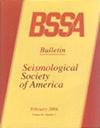A Detailed View of the 2020–2023 Southwestern Puerto Rico Seismic Sequence with Deep Learning
IF 2.9
3区 地球科学
Q2 GEOCHEMISTRY & GEOPHYSICS
引用次数: 1
Abstract
The 2020–2023 southwestern Puerto Rico seismic sequence, still ongoing in 2023, is remarkable for its multiple-fault rupture complexity and elevated aftershock productivity. We applied an automatic workflow to continuous data from 43 seismic stations in Puerto Rico to build an enhanced earthquake catalog with ∼180,000 events for the 3+ yr sequence from 28 December 2019 to 1 January 2023. This workflow contained the EQTransformer (EQT) deep learning model for event detection and phase picking, the EikoNet-Hypocenter Inversion with Stein Variational Inference probabilistic earthquake location approach with a neural network trained to solve the eikonal wave equation, and relocation with event-pair waveform cross correlation. EQT increased the number of catalog events in the sequence by about seven times, though its performance was not quite as good as thorough analyst review. The enhanced catalog revealed new structural details of the sequence space–time evolution, including sudden changes in activity, on a complex system of many small normal and strike-slip faults. This sequence started on 28 December 2019 with an M 4.7 strike-slip earthquake followed by 10 days of shallow strike-slip foreshocks, including several M 5+ earthquakes, in a compact region. The oblique normal fault Mw 6.4 mainshock then happened on 7 January 2020. Early aftershocks in January 2020, with several M 5+ earthquakes, quickly expanded into two intersecting fault zones with diffuse seismicity: one extending ∼35 km on a northward-dipping normal fault and the other ∼60-km-long and oriented west-northwest–east-southeast on strike-slip faults. Months to years later, aftershocks moved westward, deeper, and to outer reaches of the active fault zones, with abrupt rapid seismicity migration following larger M 4.7+ aftershocks in May, July, and December 2020. The observed seismicity evolution indicates cascading failure from stress transfer on multiple critically stressed faults. High aftershock productivity results from the complex multiple-fault network hosting the sequence, which is characteristic of an immature fault system in the diffuse deformation zone around Puerto Rico, at the complicated North American–Caribbean plate boundary region.基于深度学习的2020-2023年波多黎各西南部地震序列详细视图
2020-2023年波多黎各西南部地震序列,在2023年仍在进行,其多断层破裂的复杂性和余震生产力的提高是值得注意的。我们将自动工作流程应用于波多黎各43个地震台站的连续数据,以建立一个增强的地震目录,其中包含2019年12月28日至2023年1月1日3年以上序列的约180,000个事件。该工作流程包含用于事件检测和相位选择的EQTransformer (EQT)深度学习模型,使用Stein变分推理的eikonet -震源反演概率地震定位方法,使用经过训练的神经网络来求解eikonal波动方程,以及使用事件对波形互相关进行重新定位。EQT将序列中的目录事件的数量增加了大约7倍,尽管它的性能不如彻底的分析师审查那么好。增强的目录揭示了序列时空演化的新结构细节,包括活动的突然变化,在许多小的正断层和走滑断层的复杂系统。该序列始于2019年12月28日的4.7级走滑地震,随后是10天的浅层走滑前震,包括在一个紧凑地区发生的几次5级以上地震。然后在2020年1月7日发生了6.4兆瓦的斜正断层主震。2020年1月的早期余震,发生了几次5级以上地震,迅速扩展成两个相交的断裂带,具有弥漫性地震活动:一个在北倾的正断层上延伸~ 35公里,另一个在走滑断层上延伸~ 60公里,方向为西北-西北-东-东南。数月至数年后,余震向西移动,向更深的活动断裂带外缘移动,在2020年5月、7月和12月发生4.7级以上余震后,地震活动性突然快速迁移。观测到的地震活动演化表明,多个临界应力断层的应力传递导致了级联破坏。在复杂的北美-加勒比板块边界地区,波多黎各周围弥漫性变形带的不成熟断层系统具有复杂的多断层网络承载层序的特征,余震产率高。
本文章由计算机程序翻译,如有差异,请以英文原文为准。
求助全文
约1分钟内获得全文
求助全文
来源期刊

Bulletin of the Seismological Society of America
地学-地球化学与地球物理
CiteScore
5.80
自引率
13.30%
发文量
140
审稿时长
3 months
期刊介绍:
The Bulletin of the Seismological Society of America, commonly referred to as BSSA, (ISSN 0037-1106) is the premier journal of advanced research in earthquake seismology and related disciplines. It first appeared in 1911 and became a bimonthly in 1963. Each issue is composed of scientific papers on the various aspects of seismology, including investigation of specific earthquakes, theoretical and observational studies of seismic waves, inverse methods for determining the structure of the Earth or the dynamics of the earthquake source, seismometry, earthquake hazard and risk estimation, seismotectonics, and earthquake engineering. Special issues focus on important earthquakes or rapidly changing topics in seismology. BSSA is published by the Seismological Society of America.
 求助内容:
求助内容: 应助结果提醒方式:
应助结果提醒方式:


